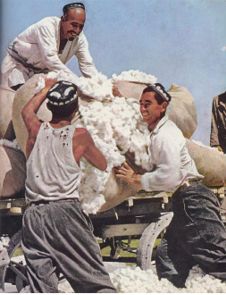How does cotton fair environmentally and socially as a material?
The environmental impacts associated with the cultivation of cotton are well known and include:
- reduced soil fertility;
- soil salinisation;
- loss of biodiversity;
- water pollution;
- adverse changes in water balance;
- pesticide-related problems including resistance; and
- severe health problems relating to exposure to acutely toxic pesticides.
The total area of land dedicated to cotton growing has not changed significantly since the 1930s (at around 33 million hectares); however in that time output has tripled. Intensive cotton production causes a range of environmental impacts; mainly in cotton producing nations.

Pesticides
- Cotton is highly vulnerable to insect attack, is normally cultivated as a monocrop and therefore cannot be sustained without large quantities of pesticides and fertilisers.
- In monocropping the natural systems of nutrient cycling and pest control become redundant. Pesticides account for more than 50 per cent of the total cost of cotton production in most of the world.
- The most widely used groups of pesticides on cotton are insecticides and have been classified by the World Health Organisation as 'moderately hazardous'. However, some insecticides that are widely used, especially in developing countries, are classified as 'highly hazardous', these are generally acutely toxic and are nerve poisons.
- Cotton fibre production also requires large quantities of fungicides, herbicides and defoliants. Large amounts of synthetic fertilisers (often based on nitrogen compounds) are also used and can result in nitrate contamination to water. Fertiliser pollution of water can cause accelerated growth of aquatic plants and algae and lead to eutrophication, which can deoxygenate the water to a state in which it cannot support animal life.
Water consumption
Water consumption in cotton fibre production is another significant factor
and ranges from 29000 litres in Sudan to 7000 litres in Israel. As all
irrigation water contains some soluble salts it causes soil salinisation,
reducing fertility.
Production
Cotton contains many impurities (seeds, dirt and plant residues) which have to be removed to convert it into useful textile fibres. About one third of the raw material is cotton fibre, the rest is seeds and impurities. Hand picked cotton contains considerably fewer impurities than cotton which is machine picked.
Naturally coloured cotton
- Naturally coloured fibres produce a fibre which does not have to be bleached or dyed.
- Naturally pigmented or 'native' cottons were conserved by traditional peoples and have a range of colours including beige, brown, green and mauve.
- However, there are a number of problems associated with these cotton varieties, such as short staple and fineness which has limited wider industry interest.
GM cotton
The genetic modification (GM) of biological species via the use of bacteria, fungi or enzymes has implications for the textile sector. Two types of genetically modified cotton have been introduced in the last two years: Bt-cotton which contains a gene that enables the plant to produce its own pest-killing toxin, and herbicide resistant cotton developed to tolerate specific herbicide applications. The reported benefits of both of these varieties lie in the reduced levels of pesticide application required. However, like all GM technology there are concerns about pest resistance and that these genes will transfer to and become established in wild relatives of the cotton crop.
(Source: Kate Fletcher, 1999 www.demi.org.uk)